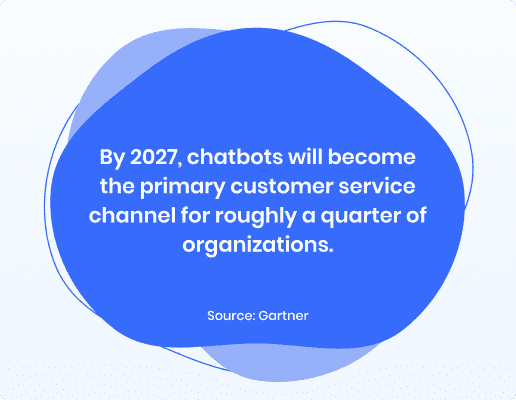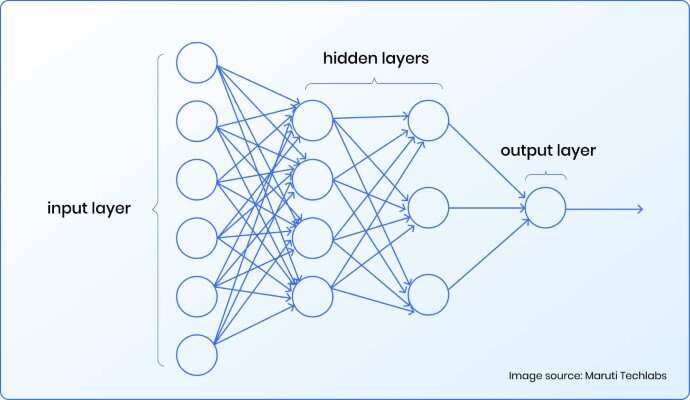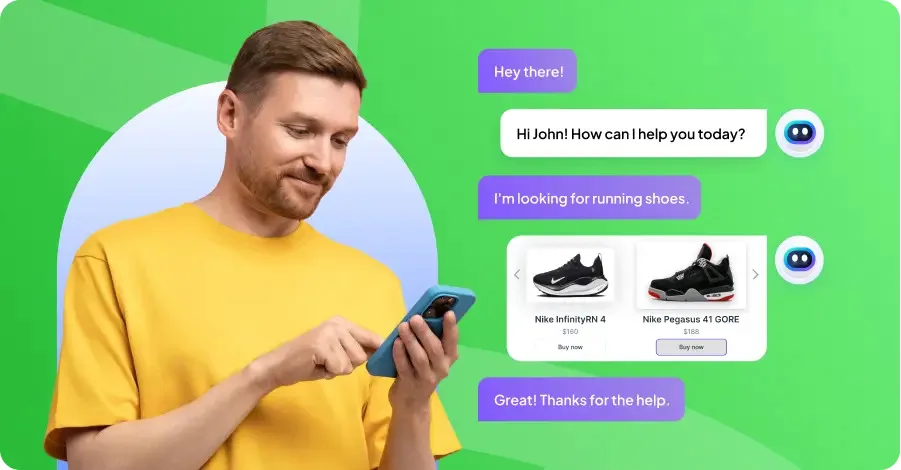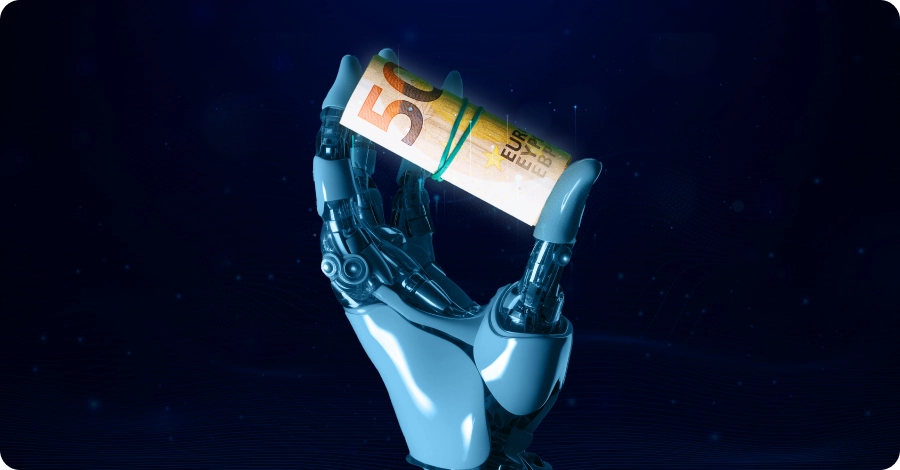How Do Chatbots Work? A Complete Guide
- December 5, 2022
- 22 mins read
- Listen

Table of Content
While browsing several websites, or maybe getting in touch with a company, most of us must have encountered a very helpful and kind chatbot. The chatbots used to be very stiff and could answer only very generic questions. But with the invention of AI (Artificial Intelligence), chatbots have become smarter, much more intuitive, and can work efficiently in place of a human customer support agent. But one question always comes to our mind, “how do chatbots work?”
We all know that chatbots are in the trend for a couple of years now. Initially, we were a bit apprehensive about its usability, thinking that it would gradually fade away with time. But actually, we all were wrong. Soon, it has become a favorite for many businesses. No matter how big or small the company is, chatbots are more than a necessity for providing automated customer service and increased sales conversions.
As per a recent survey conducted by Facebook, more than 50% of people want to do business with companies that provide live chat services. Chatbots are getting popular too fast among both customers and organizations because of the user-friendly approach, reduced manpower, and waiting time.
Many of us want to know how chatbots work. Is it a complex process? Though it’s getting popular quickly, it is still a new concept for many of us. We all are still learning about the new technologies, how these chatbots work, how to use these bots in customer service, and so on.
So, here’s a helpful guide to give you an understanding of what chatbots are and how different types of bots work towards customer satisfaction.
What is a Chatbot?
‘A chatbot is a computer program developed to talk to humans and automate various other business operations.’
It can understand what the person on the other side is saying and based on that responds instantly. For example, suppose you are trying to buy something from an online store and are stuck in the payment section. You can ask the chatbot how to make the payment to place an order, and it will help you. Sometimes, you won’t even understand that you are talking with a robot, not a real person. This is the beauty of chatbots.
Chatbots can mimic human interactions. Through textual data and voice commands, the interaction takes place between the machine and a real person. Chatbots can work independently without any kind of assistance. You need to configure the bots with various FAQs that customers tend to ask frequently.
Based on that, chatbots can respond to common queries. With AI chatbots, replying to customer queries has become more real. Pre-configured scripts and Machine Learning (ML) algorithms help bots to independently interact with humans.
Benefits of Chatbots
With continuous advancements in technology, chatbots have become more powerful than ever. Today, they handle everything from answering customer inquiries to streamlining various business operations. But beyond their technical capabilities, chatbots offer a wide range of benefits that can significantly impact both customer satisfaction and business efficiency. Let’s explore some of the key advantages chatbots bring to the table.
1. Instant Customer Service 24/7
Bots are machines, not humans! So, they don’t need rest and holidays. Chatbots can handle multiple customer queries at a time, 24/7 enabling companies to offer instant assistance round the clock.
2. Lead Generation
You can use these chatbots as a tool for lead generation. Proactively they can engage with website visitors to offer instant assistance. Also by asking qualifying questions to better understand the customer’s needs and intent, bots can offer personalized assistance.
On the other hand, through those series of targeted questions, chatbots also assess a visitor’s interest level and collect valuable contact information. This data is then passed on to the sales team for follow-up, allowing businesses to focus on high-quality leads.
3. Faster Response Times
Customers love instant assistance. Many times, they need to wait in the long queue while human agents are busy assisting others. Chatbots eliminate the need for customers to wait by offering real-time assistance. Whether it’s answering FAQs, booking appointments, or providing other product-related information, chatbots handle multiple queries at a time, significantly reducing response times compared to human agents.
4. Improved Customer Experience
By offering personalized assistance and prompt responses to queries, chatbots significantly improve the customer experience. When chatbots are pre-configured with FAQs, product databases, and service workflows, they can offer solutions within seconds. For more complex queries, chatbots seamlessly transfer the conversation to a human agent with all the required details including chat history ensuring a smoother transition.
5. Overall Cost Reduction
When you hire and train new customer support agents, that can be expensive especially if your business experiences fluctuating volume of customer inquiries. In such a case, you may not need a big customer service team. Chatbots provide a cost-effective solution by automating routine tasks and general customer queries, reducing the need to keep a large customer support department.
Once you deploy a chatbot, it can handle thousands of inquiries simultaneously 24/7 without requiring overtime pay or extra resources. Here you can save more because chatbots can handle generic customer queries easily and that too much faster than a human customer support agent.
6. Data Collection and Insights
During and after every customer interaction with a chatbot, you can collect important data such as customer details, past interactions, etc. Chatbots also track the questions customers ask and, and the challenges they face. This data can be analyzed to uncover patterns and trends, providing businesses with deeper insights into customer behavior and preferences.
You can use all these important data to improve marketing strategies, optimize product offerings, and enhance the overall customer journey. Also, chatbot analytics help to identify common pain points or areas where customers need frequent assistance or mostly raise complaints. This allows businesses to address issues proactively and identify areas of improvement.
Types of Chatbots
There are mainly 4 types of chatbots, each designed to serve different purposes and offer varying levels of interaction. They differ in terms of their capabilities, programming, and training. Let’s get into the details!
1. Rule-Based Chatbot
It is also called a decision-tree chatbot. This kind of chatbot works with the help of some predefined rules. Software developers create different series of rules based on the common types of problems customer encounter and chatbots will be configured later with the predefined responses. When a customer asks something that matches the predefined rules, chatbots can answer promptly.
2. AI-Based Chatbot
Here, you can say the bot is given an artificial brain to think by itself. You can call it AI or artificial intelligence. Based on Machine Learning (ML) technology, it is able to understand most of the open-ended questions. AI chatbots are completely capable of understanding different human languages. The best part is, that the more an AI chatbot interacts with the users, the more it gets improved. It can interpret the language, human expressions, context and based on all these responses appropriately.
3. Intent-Based Chatbot
Intent-based chatbots use techniques like Natural Language Processing (NLP) to find out user intentions. These bots are more flexible and accurate compared to rule-based systems and capable of managing a wide range of customer queries. Despite their advancements, they still require significant technical expertise and may face challenges in understanding complex issues.
4. Hybrid Chatbots
Hybrid chatbots are conversational AI systems that use various technologies and methods to deliver a more flexible, accurate, and efficient user experience. They often combine rule-based systems with machine learning and artificial intelligence.
With hybrid bots, you can seamlessly manage both routine tasks and complex customer interactions. Though the implementation process is a bit complex, its adaptability and versatility makes it an ideal choice for a wide range of business requirements.
How Do Chatbots Work?
Different chatbots are developed for different purposes. An online store may use the chatbot to provide instant assistance regarding placing orders, whereas a restaurant may use it to book tables or place food orders.
In the previous section, we have discussed the 4 basic types of chatbots. Now, let’s explore how these bots operate.
-
How Do Rule-Based Chatbots Work?
Here you need to create some pre-defined playbooks and configure that to the chatbot’s backend module. Based on those pre-programmed instructions, the rule-based chatbots can perform.
Rule-based chatbot software can work in a specific way such as a click or simple ‘yes’ or ‘no’ input-based triggers. It also is capable of identifying certain specific phrases or keywords only if those are already pre-programmed.
For example, you have programmed the rule-based chatbot to answer not only if someone selects ‘red’ or ‘blue’ but also it can understand if anyone says, ‘I want a red cup’. The backend mobile of that chatbot will understand the keyword red and can respond.
-
How Do AI-Based Chatbots Work?
With the help of Natural Language Processing (NLP) and Artificial Intelligence (AI), chatbots extract thoughts and opinions from different voice and textual inputs and respond accurately.
Unlike rule-based chatbots, AI chatbots don’t depend much on predefined responses, rather the bots here try to understand what the customers are saying. Once they have found out what the customers are looking for, the bots provide relevant answers to those queries based on all the available information. With AI and NLP mechanisms, chatbots have become an effective means of providing excellent customer support.
-
How Do Intent-Based Chatbots Work?
The intent-based chatbot first recognizes the underlying purpose or goal behind a user’s message and responds accordingly. To accomplish this, bots typically use advanced techniques such as Natural Language Processing (NLP) and intent recognition.
A user’s intent indicates what he/she aims to achieve, whether he is requesting more information about a product or seeking assistance with placing an order. When a customer sends a message, an intent-based chatbot begins analyzing the text to identify a matching predefined intent.
Based on this understanding, the chatbot generates the appropriate response or takes relevant actions to fulfill the user’s request. By focusing on intent rather than exact keyword or phrase matching, intent-based chatbots offer greater flexibility and accuracy compared to rule-based systems.
Moreover, intent-based chatbots can remember past messages during interactions, and maintain contextual understanding throughout the conversation. This capability enables them to provide more accurate and relevant responses, creating a smoother and more conversational user experience.
-
How Do Hybrid Chatbots Work?
Hybrid chatbots combine the strengths of rule-based, intent-based, and machine-learning approaches to deliver a flexible and efficient conversational experience. They typically work on predefined rules or intents for specific tasks. The bots also incorporate AI to enhance performance, adaptability, and the ability to understand natural human language.
When a user begins a conversation—whether through a messaging platform, website, or app—the hybrid chatbot first analyzes the text to identify the user’s intent and extract relevant details. This process is often powered by natural language processing (NLP) techniques.
Some hybrid chatbots are designed to learn from user interactions and feedback. Over time, they get improved and start performing better by gathering more data and refining their responses. Apart from that when the chatbot encounters any complex request, it smoothly transfers the interaction to a human agent.
3 basic classification models based on which the chatbots work
1. Pattern Match
By pattern, here we mean a basic regularity amongst some of the words. Chatbots, use such kind of pattern-matching techniques to classify the textual inputs and provide an appropriate response to the users. A basic structure for such a pattern can be called ‘Artificial Intelligence Markup Language (AIML).
The interesting part is chatbots can guess how the components of such patterns repeatedly appear. Software developers use these patterns and create repetitive behaviours for the chatbots.
For instance, here the developers use some massage patterns that will match some parts of the customer’s massages.For example, if the user is saying, “Hi, I have a query”, a message pattern like ‘query’ has to be used.
Let me share with you some examples here.
Message 1. Hi, I need assistance. Here developer needs to add pattern ‘assistance’
Message 2. How to place an order. Here the developer needs to add pattern ‘order’
Message 3. My phone is broken. Do you have any warranty? Here the developer needs to add the pattern ‘phone is broken. Warranty’
Chatbots will be able to answer these questions because those specific words are present in the patterns unless they won’t be able to provide any response. To work beyond those associated patterns, developers need to take the help of algorithms.
2. Algorithms
For getting the chatbot ready with all the adequate responses, it was become mandatory to add several unique patterns in the main database. Developers create a hierarchy with the permutation and combination of different patterns.
So, it’s actually tough with such a big structure. Algorithms help here to make it more manageable by reducing the total number of different types of classifiers. This is more of a simplified solution which is basically named as the ‘Reductionist’ approach.
For better understanding let me give you an example here are a couple of sentences that can be classified with the same group. For new text inputs, each word will be counted as per the commonality and occurrence. Then every class will get a score. The class getting the highest score will be added to the input sentence.
Example of a set of words and how it gets scored.
Class: Order
“Where is my order?”
“sales”
“How to buy!”
Sample Input Sentence Classification:
Input: “Hello, where is my order.”
Term: “Hello” (no matches)
Term: “Order” (class: Order)
Term: “Where” (class: Order)
Classification: Order (score=2)
Here, based on an equation, for every class, text matches are scored for the above-shown sample sentences. Here the classification score identifies the highest text-matched class but there are some limitations also. The score may guarantee the exact match. The highest-scored class may only give a relativity base.
3. Artificial Neural Networks (ANN)
ANN is basically a system built with different interconnected nodes or components named ‘neurons.’ These neurons are shaped in layers. These neurons use external inputs by users, process those data, and then enable the chatbots to respond.
These generative bots work on artificial neural networks, whereas the algorithm-based bots always need a database with generic responses to respond from. In ANN, the more chatbots detect new patterns to provide accurate responses, the more they get stronger and more accurate in understanding human outputs. The neural network has 3 layers-input layers, hidden layers, and output. These layers together help in learning and analyzing a different kind of data.
All About Natural Language Understanding (NLU)
NLU comes under the domain of AI which by using different software applications, figures out user inputs( text or voice data).
Natural language processing helps to initiate a conversation between a real person and a computer. The person on one side can speak any language like English, Chinese or Spanish, and the computer on the other side will be able to understand those inputs. Not only this, NLU lets the computer reply back to the person in his own language.
NLU creates different high-end voice and chat-equipped bots that can converse with people without any kind of intervention. NLU helps the chatbot understand the query by breaking it down. It has three specific concepts:
1. Entities
Here, a chatbot picks up specific keywords from the user’s inputs to understand what he wants to convey. For example, suppose the user is asking,” where is my order?”, here the chatbot will pick up the keyword ‘order’ as the entity to get an idea about his query.
2. Intent
It basically finds out what is the required action that the bot will take for the user’s query or input. For example, the intent of “I want to know about my order status”, and “where is my order” will be the same. All these user inputs help the chatbot to understand the command of providing him information regarding his recent purchase.
3. Context
For the NLU algorithm, it’s tough to measure the context of user inputs as it does not have the whole conversation history. The state has to be restored for choosing the appropriate phrases during the interaction.
It can show different phrases like ‘Order a burger or other parameters like ‘apparel-T-shirt’. With this context, you will be able to relate the intent without even knowing the exact question.
All About Natural Language Processing (NLP)
Different chatbots have different capabilities, they are not equal. For rule-based models, chatbots respond as per the pre-defined answers for specific phrases. Some advanced chatbots powered my AI and natural language processing, can read the inputs, understand and reply instantly that too in human language.
NLP comes under the same domain of AI and machine learning that helps chatbots to analyze and understand users’ text or voice data and provide appropriate answers, even improving overall performance in due time.
NLP chatbots convert the user’s textual or voice data into structured data through some basic steps and then respond accordingly. Some of the NLP steps are mentioned below:
-
Sentiment Analysis
Here the algorithm interprets the user’s thoughts, opinions, and sentiments from the given textual or voice data inputs.
-
Tokenization
Next, natural language processing breaks a chain of texts or words into several small chunks of words that can be called tokens. Being a single entity, tokens work as building blocks for several paragraphs. These broken words are helpful for chatbots to work efficiently.
-
Entity Recognition
Next, the chatbot searches for several categories of texts, for example, the name of the service, the customer’s name or geographic location, company name, etc based on what is required.
-
Normalization
Here the chatbot model goes through the user’s input to find any kind of spelling or typing errors. It’s basically the pre-processing part to improve the overall quality of user inputs to make it appropriate for the chatbots to process.
-
Dependency Parsing
The chatbots go through common words, nouns, verbs, etc in the user’s inputs to figure out some related phrases that the user may try to say.
Just like other software applications, chatbots are also interconnected with different knowledge bases or databases. We can use the stored data to configure chatbots for providing suitable replies to customer queries.
AI Chatbots by REVE Chat
REVE Chat is an omnichannel AI powered customer engagement platform that offers instant assistance to customers on web, mobile apps and other social media platforms like Facebook, Instagram, Telegram, Viber and WhatsApp. Apart from providing live chat support, voice and video chat facilities, REVE Chat also has come up with AI-powered chatbot for companies to automate and manage customer support and other business operations.
REVE Hybrid Chatbot integrates advanced AI technology with human support to deliver an automated and best in class customer experience.
Key Features:
- Customer Service FAQs
- Sentiment Analysis
- Fall Back Option
- Bot Analytics
- Data Sanitization
- Visual Flow Builder
- Seamless Human Handovers
Want to see how REVE Chatbot can work wonders for your online store? Sign Up for a 14-day FREE TRIAL today!
How to Create a Chatbot with REVE Chat?
Creating a chatbot involves several key steps, from choosing the right platform to designing and deploying the bot. REVE Chatbot can be created with zero coding language and does not need such technical skills to get started.
To know more about how you can build your bot with REVE Chat, check out ‘10 Simple Steps to Create a Chatbot For Your Website.’
Common Use Cases of Chatbots
With the help of AI and natural language processing, chatbots can interact with users in real-time, and offer accurate responses improving efficiency and enhancing customer experiences. These bots can be used for everything from answering common customer queries to providing personalized recommendations, helping businesses save time and resources. Whether for customer support, sales, marketing, or internal operations, chatbots offer a versatile solution for many different use cases.
Here are some key use cases where chatbots are making a significant impact:
1. Automated Customer Service
Chatbots offer automated customer service and round-the-clock real-time assistance to ease human agents’ workload. When you configure these bots with all the required data, they respond to customer questions accurately, provide information, help with troubleshooting, and even pass on the more complex issues to human agents when required.
2. Insurance
Insurance chatbots function as digital advisors and offer assistance to a wide range of users, including potential clients, policyholders, brokers, and third parties. These bots streamline various processes by assisting with claims submissions and tracking, ensuring that users can file and monitor their claims effortlessly. Additionally, they can generate personalized insurance quotes based on user inputs, making it easier for customers to explore and compare coverage options.
3. Internal Training Purposes
Chatbots can also serve as AI Agent Training Simulators for internal training. Such bots allow your support agents to practice handling various customer service scenarios through simulated interactions. With this approach, agents can improve their communication skills, practice how to troubleshoot problems and navigate difficult conversations in a safe, controlled environment.
4. Virtual Shopping Assistants
In the eCommerce sector, chatbots play a key role as virtual shopping assistants, delivering personalized experiences to customers. From suggesting products based on browsing behavior and preferences to offering tailored recommendations, they help customers discover items that fulfill their requirements. Chatbots also help in placing orders by guiding users through checkout, ensuring a seamless and efficient shopping experience.
5. Order and Inventory Management
Chatbots integrate smoothly with sales tracking software to enhance the customer experience by providing real-time information. They can quickly inform customers about which products are currently in stock, helping shoppers make informed decisions. Additionally, these bots offer accurate shipping estimates, ensuring customers know when to expect their orders.
Even after a purchase, you can configure your bot to engage with customers to offer updates on order status, including tracking information and delivery timelines. This proactive communication helps build trust and keeps customers informed throughout the shipping process.
Basic Challenges of Chatbots
Every new technology comes with its own set of challenges. Chatbots are no exception. Below, we have highlighted some of the most common issues that you may face with chatbots and also provided strategies to address them using REVE Chatbot.
-
Hallucinations
This can occur when from a customer’s input, AI identifies patterns without fully understanding the underlying information. In such a case bots can generate responses that are either factually incorrect or entirely fabricated.
Solution: To handle such situations, invest in a good AI chatbot that is capable of detecting accurate customer sentiment and deliver correct answers, especially during complex interactions. REVE Chatbot uses advanced sentiment analysis to accurately interpret customer inputs and provide precise, relevant responses based on the information received.
-
Security and Privacy Concerns
Chatbots often handle sensitive customer data, such as personal information, payment details, or account credentials. If not properly secured, chatbots can be vulnerable to data breaches, phishing attacks, or unauthorized access, putting customer privacy at risk.
Solution: Equipped with advanced customer data privacy and protection, REVE Chatbot, allows you to automate services while maintaining top-tier privacy and security standards.
-
Lack of Human Touch
One major complaint from customers is that bots sound too mechanical. They often lack the empathy and emotional intelligence needed to connect with customers on a human level, especially in complex situations where customers need reassurance.
Solution: Personalization is key to overcoming this challenge. REVE Chatbot offers personalized assistance based on saved customer details like their buying patterns, past interactions, etc. Also, in case the situation is too complex, and the customer needs to be handled with more care, through the ‘Fallback Option’ REVE Chatbot transfers the interaction to a human agent ensuring no data is lost in the process.
-
Implementation Timelines
Deploying a chatbot requires careful planning, time, and resources to ensure successful integration. The timeline depends on various factors such as the complexity of the bot, the level of customization needed, the integration with existing systems, and the goals of the business.
Solution: REVE Chatbot enables your team to quickly build, deploy, and customize their chatbot without any coding and technical skills required.
-
Language Barriers
Many chatbots face challenges in understanding diverse languages and dialects. This can lead to communication gaps, particularly if you have a global business serving multilingual and culturally diverse customers.
Solution: REVE Hybrid Chatbot offers multilingual assistance to your customers worldwide. So, language is not a barrier anymore!
The Future of Chatbots
In 2023 and 2024, we have seen rapid and significant growth in chatbot technology, with an increased role of AI in online sales and the digital world at large.
And trust me, this is just the beginning. As the responses by chatbots have become more accurate than before, positive interactions and customer satisfaction have also increased. A recent study found that 80% of customers had a satisfying experience engaging with bots.
So, where is chatbot evolution heading? Like other AI tools, chatbots will also be used to enhance human capabilities, allowing people to focus on more strategic, creative, and innovative tasks, rather than routine ones. In the near future, businesses, employees, and customers will have more advanced and enhanced chatbot features like faster product recommendations, more accurate responses to queries, and seamless access to high-definition video conferencing within conversations.
Here’s a look at what to expect:
- Chatbots will become more advanced and offer more personalized experiences by analyzing user buying behavior, preferences, and past interactions.
- With enhanced NLP and AI, chatbots will be better equipped to understand the context of any conversation and respond accordingly.
- As voice recognition technology improves, voice-based chatbots will become more popular.
- Chatbots may soon be able to detect and respond to users’ emotions based on their language, tone, or even facial expressions (in video chats).
- With AI advancements, chatbots will become more effective at nurturing leads and driving sales.
- Rather than replacing human agents, future chatbots will work alongside them to offer a better customer experience.
Wrapping Up!
Most businesses today have an online presence. To connect with the largest audience, provide effective customer support 24/7 and automate the whole support system, it’s high time that you should consider adding a chatbot to your website. Chatbots can interact with consumers without even letting them understand that they are actually talking to a machine, it’s that efficient. What are your thoughts on this? Let me know in the comment section below.
Frequently Asked Questions
A bot is a general term for any automated program that can perform specific tasks by itself, typically without human intervention.
A chatbot, on the other hand, is a type of bot specifically designed to automate conversations with users. Chatbots use AI and Natural Language Processing (NLP) to understand and respond to text or voice inputs, making them ideal for various business operations, customer service, or providing personalized assistance.
Yes, chatbots are often considered AI, but the level of AI can vary. Simple rule-based chatbots follow predefined scripts and respond accordingly, which doesn’t involve advanced AI.
However, more sophisticated chatbots like AI bots use artificial intelligence, particularly natural language processing (NLP) and machine learning (ML) technologies to understand context, interpret user inputs, and respond accurately.
No, besides websites, chatbots can be integrated across various channels such as mobile apps, messaging platforms, social media, and voice assistants like Alexa or Google Assistant.
You can integrate chatbots with customer relationship management (CRM) systems, eCommerce platforms, messaging apps, mobile apps, and other business tools using APIs.
Chatbots can be secure, provided they are designed with encryption, data protection, and compliance measures.
ChatGPT differs from traditional chatbots in its advanced capabilities and underlying technology. Typical rule-based chatbots follow predefined scripts and respond to specific keywords, while narrow AI chatbots are limited by their specialized training data.
ChatGPT, powered by a large language model, uses deep learning and natural language processing (NLP) to understand and generate human-like text. Additionally, ChatGPT can also generate creative content and learn from interactions, while traditional chatbots are usually limited to specific functions or tasks.





